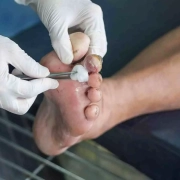Deucravacitinib improves outcomes in patients with psoriasis arthritis: Study

Psoriatic arthritis is a chronic and debilitating autoimmune disease which leads to significant physical disability and diminished quality of life. The traditional treatments often come with various side effects and this highlights the need for safer and more effective options. A recent phase 2 trial published in the Arthritis Care & Research journal showed the potential benefits of Deucravacitinib, a TYK-2 inhibitor, from the perspective of the patient with psoriatic arthritis (PsA).
This double-blind trial included a total of 203 participants to assess the efficacy and patient-reported outcomes (PROs) of the two dosage levels of Deucravacitinib when compared to a placebo. The participants in the trial were randomly assigned to receive either 6 mg or 12 mg of Deucravacitinib once daily or a placebo, over a 16-week period.
The study primarily focused on the change from baseline in the Health Assessment Questionnaire Disability Index (HAQ-DI) and the 36-item Short Form Health Survey (SF-36) physical component summary (PCS) score at Week 16. These measures were crucial in assessing physical function and overall health status that provides insight into the impact of treatment from the patient’s view.
The results found that both dosages of Deucravacitinib significantly outperformed the placebo in improving HAQ-DI and SF-36 PCS scores. The adjusted mean difference in HAQ-DI score at Week 16 was −0.26 (P = 0.0020) for the 6 mg dose and −0.28 (P = 0.0008) for the 12 mg dose indicated a notable improvement in physical function. Similarly, the SF-36 PCS scores improved by 3.3 points (P = 0.0062) and 3.5 points (P = 0.0042) for the 6 mg and 12 mg doses, respectively which suggests enhanced quality of life.
Moreover, a significant percentage of patients reported improvements in patient-reported outcomes that included fatigue, pain and mental health after reaching or exceeding the minimum clinically important differences (MCIDs) or achieving normative values. This indicates that Deucravacitinib not only improve the physical health but also positively affects the overall wellbeing.
Overall, these findings underscore the potential of Deucravacitinib as a transformative treatment for psoriatic arthritis. The significant and clinically meaningful improvements in patient-reported outcomes that highlight its capacity to address both the physical and psychological aspects of the disease.
Reference:
Strand, V., Gossec, L., Coates, L. C., Ogdie, A., Choi, J., Becker, B., Zhuo, J., Lehman, T., Nowak, M., Elegbe, A., Mease, P. J., & Deodhar, A. (2024). Improvements in patient‐reported outcomes after treatment with deucravacitinib in patients with psoriatic arthritis: results from a randomized phase 2 trial. In Arthritis Care & Research. Wiley. https://doi.org/10.1002/acr.25333
Powered by WPeMatico



















